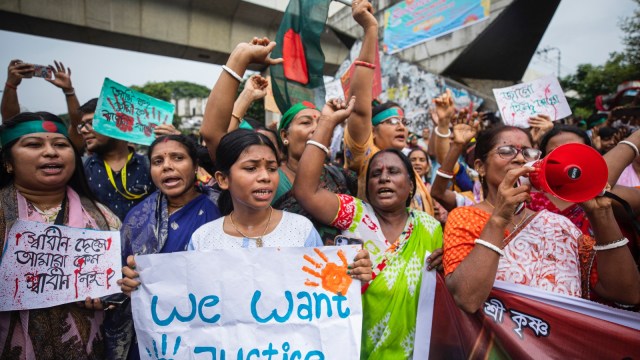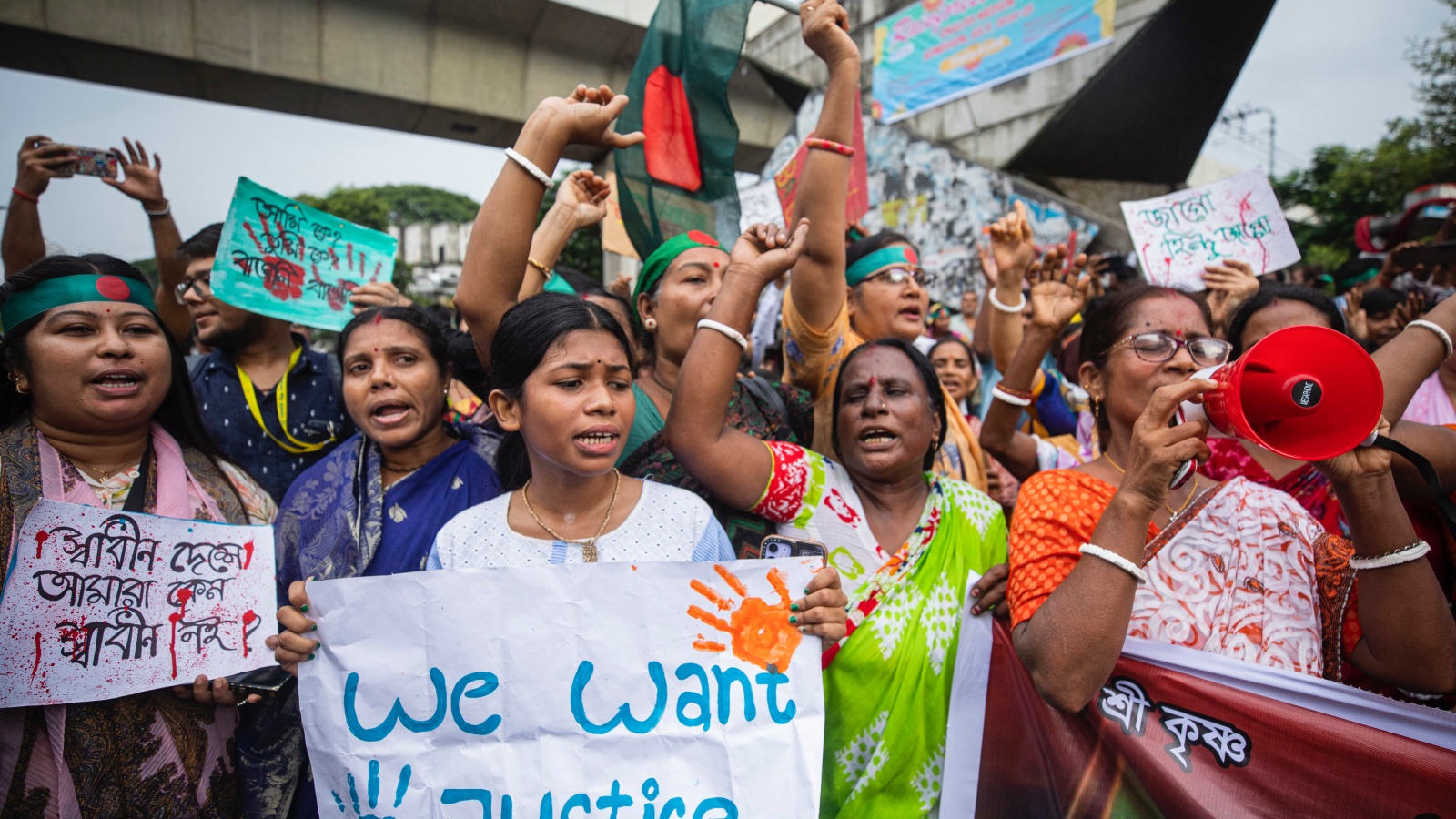
While various reasons can be attributed to the events in Bangladesh over the last few days, the autocratic governance style of the deposed Prime Minister is now being advanced as central to this narrative. However, viewing the present unstable situation through the narrow prism of recent events will blur the fault lines and contradictions that have existed in the country’s society and polity since its creation.
There is an ongoing conflict between Bengali culture and Islamic resurgence in the country. Like India, there are overlapping identities, including religious ones, in Bangladesh. Three main identities are vying with each other for pre-eminence. The first is based on a secularist-nationalist discourse, the second is the Islamic identity and the third is popular Bengali culture, which is more accommodating and syncretic. However, in the issues related to national and Muslim identities, some conflicting and mutually exclusive elements are at play. In erstwhile East Bengal, the creed of Islam was imbibed by the people, but not the culture — Sufism easily blended with elements of Hinduism. Bengali popular culture is the safeguard against any kind of extremism, including Islamic hardliners. This should be the dominant identity of Bangladesh, even in opposition to the secular ideology, which per se is an isolated minority.
Approximately 90 per cent of Bangladesh’s population practices Islam. The amended constitution has also restored the article providing for freedom of religion and secularism. I had the opportunity to interact with senior defence and civil services officers while attending the National Defence Course in Dhaka. Surprisingly, even some of the army officers were vocal about the need for the paramount importance of Islam in the functioning of the state and questioned the restoration of the word “secularism” in the constitution through the 15th amendment.
Second, a major fault line is rooted in the country’s history. Bangladesh has hard divisions between various groups, which go back to who took part in the War of Liberation or stayed out of it, according to their political values, beliefs and ideologies. Since India played a major part in the creation of Bangladesh, its role is central to the narratives of these groups. The nationalists felt that India’s role was limited to bringing Bangladesh under its sphere of influence to further its economic interests and gain better access to North-Eastern India. The pro-Chinese Left believed that India’s intention was to make Bangladesh a colony for importing raw materials to cater to the jute industry in West Bengal. The radical Left perceived India as an expansionist power and believed that Bangladesh’s liberation was an unfinished revolution. The Islamists propagated that India’s real motive was to break up Pakistan, the Muslim homeland, as Hindus had never reconciled to the idea of an independent Islamic state.
Not well known in India, the Mukti Bahini, consisted of diverse ideological entities, some of which also resented India’s role. It had reluctantly fought under India’s overall command of India and could not reconcile to its predominant role. The surrender ceremony was perceived more as an Indian show than a Bangladeshi one despite the fact that Group Captain A K Khondker, who later became Air Chief, was present. In fact, in Bangladesh, it is politically incorrect to mention the 1971 conflict as the India-Pak war. Further, in the national museum at Dhaka, very few displayed items reflect India’s role in its Liberation War. Even the iconic photograph of the surrender ceremony does not find a place.
All these perceptions gave rise to propaganda that India’s help in the liberation struggle had come with a price. It then became politically expedient to blame India for all the problems Bangladesh has been facing ever since. The narrative of India being hegemonic propels the dominant discourse on its neighbour in Bangladesh. Bangladesh’s perceptions of India are also shaped by the fractured nature of its polity and society.
There is indeed a wide divergence between government-to-government interaction and public perception in Bangladesh. Minor irritants like delays in getting visas for travel to India and border incidents are perceived by the population as unconstructive policies of the Indian government, overshadowing the co-operational benefits. Misperceptions are also in abundance like India is carrying out a cultural invasion by beaming its TV channels to Bangladesh while blocking Bangladeshi channels in India, especially in West Bengal. Despite periodic explanations by our High Commission that it is merely due to commercial reasons wherein Bangladeshi broadcasters are not ready to pay any “carry fee” to Indian cable TV service providers, the issue is flogged periodically.
Bangladesh has also been unable to institutionalise stable civil-military relations, despite many years of democracy. The country continues to still live under the shadow of the military. The principal reason for this is in the nature of its politics, which is characterised by deadly confrontations, revenge, and struggles for power by the two major political parties, giving rise to a dysfunctional democratic order with a questionable record of institution-building. Due to mutual antagonism, successive regimes have wanted to keep the military on their respective sides. There is also the widely accepted perception that to win the elections, they need the tacit support of the army. The holding of the defence minister’s portfolio by the prime minister since 1975, bifurcation of the defence ministry and placement of the armed forces division under the PM, have blocked the traditional command channel through the defence ministry under which the chiefs of the three services function in other democracies. These developments, as well as their attempts to win over the military, have accelerated the politicisation of the institution.
The Bangladesh army in particular and the defence forces in general, like Pakistan, are deeply involved in controlling commercial activities. Evidence of the army’s wealth and influence is not hard to find. The five-star Dhaka Radisson Hotel — which offers guests use of the nearby deluxe army golf course — is owned by the Bangladesh Sena Kalyan Sangstha and is established on military land.
The army is often called out to perform frivolous tasks for the civil administration such as control of traffic in the national capital, election security duties and distribution of water during the lean season. The army is also routinely employed in high-profile national projects such as the preparation of national ID cards and voter lists. In 2007, the military-backed caretaker government granted the army exclusive rights to receive fees for passports. The reasons for this unusual practice can be attributed both to the over-exuberance of the army and the government playing safe by avoiding the risk of social unrest. This enhances the army-public interface, leading to detrimental effects on the functioning of the army.
These systemic incongruities make Bangladesh more divisive and vulnerable than any external factors at play in the current turmoil. They also provide context to the recent turbulence leading to attacks on minorities, the wrecking of the Indira Gandhi Cultural Centre in Dhaka, the ransacking of business establishments, the destruction of the Bangabandhu museum, refusal of the army to quell the protests, especially in initial stages and allowing the situation to become uncontrollable.
The writer is a former Vice Chief and Southern Army Commander of the Indian Army



